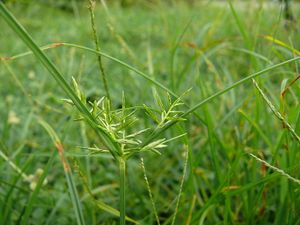Note: This is a project under development. The articles on this wiki are just being initiated and broadly incomplete. You can Help creating new pages.
Difference between revisions of "Cyperus rotundus - Mustaka"
m (Jayashree moved page Cyperus rotundus to Tunge Gadde) |
|||
| Line 1: | Line 1: | ||
[[File:800px-Cyperus rotundus - Kourou.jpg|thumb|right|''Cyperus rotundus'', ''Tunge Gadde'',]] | [[File:800px-Cyperus rotundus - Kourou.jpg|thumb|right|''Cyperus rotundus'', ''Tunge Gadde'',]] | ||
| − | |||
'''Cyperus rotundus''' is a perennial plant, that may reach a height of up to 140 cm (55 inches). The names "nut grass" and "nut sedge" – shared with the related species Cyperus esculentus – are derived from its tubers, that somewhat resemble nuts, although botanically they have nothing to do with nuts.The root system of a young plant initially forms white, fleshy rhizomes, up to 25 mm in dimension, in chains. Some rhizomes grow upward in the soil, then form a bulb-like structure from which new shoots and roots grow, and from the new roots, new rhizomes grow. Other rhizomes grow horizontally or downward, and form dark reddish-brown tubers or chains of tubers. | '''Cyperus rotundus''' is a perennial plant, that may reach a height of up to 140 cm (55 inches). The names "nut grass" and "nut sedge" – shared with the related species Cyperus esculentus – are derived from its tubers, that somewhat resemble nuts, although botanically they have nothing to do with nuts.The root system of a young plant initially forms white, fleshy rhizomes, up to 25 mm in dimension, in chains. Some rhizomes grow upward in the soil, then form a bulb-like structure from which new shoots and roots grow, and from the new roots, new rhizomes grow. Other rhizomes grow horizontally or downward, and form dark reddish-brown tubers or chains of tubers. | ||
| − | It prefers dry conditions, but will tolerate moist soils, and often grows in wastelands and in crop fields. | + | It prefers dry conditions, but will tolerate moist soils, and often grows in wastelands and in crop fields.<ref name="int"/> |
Cyperus rotundus improves lactation, relieves fever, burning sensation, excessive thirst. Commonly known as '''nut grass''', it is also used in treating diarrhea, dyspepsia, herpes and more. | Cyperus rotundus improves lactation, relieves fever, burning sensation, excessive thirst. Commonly known as '''nut grass''', it is also used in treating diarrhea, dyspepsia, herpes and more. | ||
| + | |||
| + | == References == | ||
| + | |||
| + | <references> | ||
| + | <ref name="int">[http://aciar.gov.au/files/node/11477/mn141_weeds_of_upland_crops_in_cambodia_khmer_tr_19691.pdf "weeds of upland crops in cambodia"]</ref> | ||
| + | </references> | ||
| + | |||
| + | == External Links == | ||
| + | |||
| + | *[https://en.wikipedia.org/wiki/Cyperus_rotundus Cyperus rotundus-Wikipedia] | ||
[[Category:Herbs]] | [[Category:Herbs]] | ||
Revision as of 10:15, 4 January 2017
Cyperus rotundus is a perennial plant, that may reach a height of up to 140 cm (55 inches). The names "nut grass" and "nut sedge" – shared with the related species Cyperus esculentus – are derived from its tubers, that somewhat resemble nuts, although botanically they have nothing to do with nuts.The root system of a young plant initially forms white, fleshy rhizomes, up to 25 mm in dimension, in chains. Some rhizomes grow upward in the soil, then form a bulb-like structure from which new shoots and roots grow, and from the new roots, new rhizomes grow. Other rhizomes grow horizontally or downward, and form dark reddish-brown tubers or chains of tubers. It prefers dry conditions, but will tolerate moist soils, and often grows in wastelands and in crop fields.[1]
Cyperus rotundus improves lactation, relieves fever, burning sensation, excessive thirst. Commonly known as nut grass, it is also used in treating diarrhea, dyspepsia, herpes and more.
